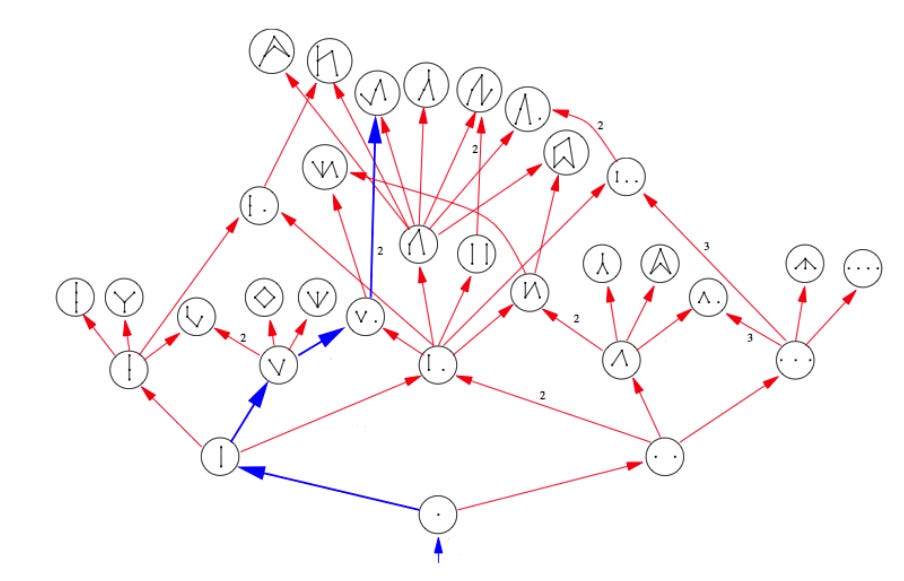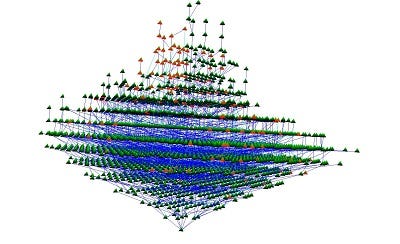What If There Was No Spacetime?
When Only the Meeting Matters: How Causal Sets Could Rebuild Space, Time, and Physics Itself
Imagine a universe in which nothing has a location until it bumps into something else. No orbiting electrons, no flying photons, no vast, empty void between the stars — only an ever growing family tree of particle encounters: here an atom nucleus scatters a neutron, there two gluons fuse inside a proton. Each link in that tree is an interaction, and the links are all that exist. We sometimes do just that in particle physics simulations; why should we waste precious memory on allocating huge swaths of spacetime lattice where nothing actually happens? We are interested in events, so let’s calculate and record the events. And as it turns out, the same thing happens in physical reality.
That stark idea has been floating around the fringes of theoretical physics for decades (parts of it well understood since Einstein’s point events and Feynman’s path integrals). But in the past few years it has snapped into much sharper focus thanks to an approach known as the causal set program. Causal sets do something radical and simple: they throw away the continuous stage on which both general relativity and quantum theory traditionally unfold and replace it with a giant network of events linked only by the order in which they can possibly influence one another.
At first glance that may look like a philosopher’s fantasy. Yet the causal set idea has matured into a concrete mathematical framework that can reproduce many familiar features of spacetime, dodge the quantum measurement problem, and even hint at testable signals in cosmic rays and gravitational waves. Some researchers now see it as a leading candidate for the long-sought “theory of everything” — the elusive unification of quantum mechanics and Einstein’s gravity.
Where Do Paradoxes Go When No One Is Looking?
Causal sets deflate so many of the spooky quantum paradoxes.
Take the famous double slit experiment. In textbook pictures a particle leaves the gun, travels as a mysterious “wavefunction” that makes it to be “here and there,” then “collapses” when it reaches the photographic plate. In a causal set world only the gun-event and the pixel-event are real. What happens in between is replaced by a set of possible chains of still-to-be-realised encounters: statistical scaffolding, not physical stuff. The interference pattern emerges from summing the amplitudes for those possible chains; there is no ghostly wave roaming the void (as there is no void at all), so nothing needs to collapse.
Schrödinger’s cat? The atom’s decay is one encounter, the Geiger click another, the cat’s heartbeat a third, your glance a fourth. Until two nodes in the chain meet (say, the counter and the cat) there is no fact about whether the cat is alive; the “superposition” is merely our bookkeeping over alternative, not-yet-realised links. The moment the chain closes, the fact exists, relative to every later relevant event including you. No additional metaphysics, no parallel worlds.
Even the “delayed-choice” and “quantum eraser” puzzles lose their sting. You can add or remove slits after the photon is emitted, but you cannot insert an encounter that lies outside the partial order; causality is built into the set. Any late tweak simply carves a different set of allowable chains, and the statistics adjust without paradox.
Middle spaces simply do not exist in a causal set. A photon could be nothing more than the chain of emission and detection events that bracket it. The wavefunction becomes a calculation device for probabilities of possible event chains, and talk of a particle’s “location in flight” is as meaningless as asking for a syllable that lies between two consecutive letters.
The Trouble With Backgrounds
Physics has two towering pillars. Quantum field theory (QFT) describes electrons, quarks and the like as ripples on fields in a smooth, globally defined spacetime continuum. General relativity (GR) speaks about the continuum in the language of metrics, a set of distances defined between objects, and the continuum is sort of extrapolated from it as a “metric tensor”, which does not need to be globally defined. Technically speaking, general relativity is background-free, and QFT is background-dependent. For half a century theorists have tried to quantize the fabric, sprinkle strings upon it, or bend QFT into background-free shapes — with limited success.
Causal sets flip the strategy. Erase the fabric altogether, say their proponents, and start from the one ingredient both quantum and relativistic physics agree on: causality. If event A can send a light signal to event B, put A before B in the set’s order; if not, leave them incomparable. Add one further rule — local finiteness, meaning that between any two events there are only finitely many others (actually very important, with many immediate consequences) — and you have a causal set, a poset in the language of mathematicians. No coordinates, no distances, not even a notion of dimension.
Remarkably, sprinkle enough points at random into an ordinary region of spacetime and, with high probability, the pattern of “can reach” and “cannot reach” among those points matches the order one would have written down in the causal set language. In other words, the geometry is already hiding in the order. Recovering it is a statistical exercise, not an axiom.
Watching Spacetime Grow on Your Laptop
Unlike the formidable numerics of lattice gauge theory, simple causal-set worlds are easy to code. With a hundred lines of Python one can:
Sprinkle a few thousand events into a causal diamond, compute which pairs are causally related, and watch the order fraction settle down to one-half — the precise signature of flat 1 + 1-dimensional Minkowski space.
Grow a universe event by event using classical sequential growth dynamics. In such models the set self-organizes into layers that mimic cosmic expansion, and tagged chains of events play the role of “particles.” Their speeds drift randomly yet the ensemble respects Lorentz symmetry: no preferred cosmic rest frame sneaks in.
Coarse-grain by contracting blocks of densely interconnected events. Successive contractions reveal how dimension flows from microscopic values near two to the familiar four at macroscopic scales, echoing similar behavior in asymptotic safety approaches.
Large-scale simulations are no longer hobby projects. GPU codes now reach millions of events, enough to model causal patches surrounding black hole horizons and to measure entropy directly from counting relations.
A New Route to a Theory of Everything?
So where does this leave the bigger quest? A convincing theory of everything must do at least three things: embrace both quantum uncertainty and gravitational curvature, stay mathematically consistent and finite at ultrahigh energies, and connect in concrete ways to the Standard Model of particle physics.
Consistency and finiteness are built into the causal-set DNA: local finiteness ensures a physical ultraviolet cutoff that respects Lorentz invariance, and ultraviolet divergences that plague continuum QFT simply never appear.
Quantum plus gravity coexist naturally because matter fields and the order they live on are treated in the same language. The gravitational path integral is a sum over orders, not over geometries, and therefore never double-counts gauge redundancies associated with diffeomorphisms.
The Standard Model remains the big unknown. Abelian gauge theories fit comfortably — one can define causal set versions of the Maxwell action. Non-Abelian Yang–Mills sectors and chiral fermions, however, are harder; the set lacks nearest-neighbour structure for constructing the analog of lattice plaquettes. Several teams are experimenting with algebraic quantum field theory tools and with “energetic causal sets,” where links carry momentum labels that transform like gauge charges. The verdict is still out.
Yet causal sets have one more trump card: possible empirical fingerprints. Planck-scale discreteness could introduce minuscule “swerves” in particle trajectories, altering the energy spectrum of ultrahigh energy cosmic rays. It could cause frequency-dependent delays in the arrival times of gravitational wave chirps from colliding black holes. Both signatures are small, but improving detectors may cross the needed sensitivity thresholds within the next decade.
A Universe That Is a Story, Not a Stage
Perhaps the most inspiring aspect of causal sets is conceptual rather than technical. In standard physics the universe is an arena furnished with actors. In the causal-set world view the arena is the play. Every “where” and every “when” is nothing deeper than a crystallised answer to the question “Did this influence that?” Layers of familiar structure: space, clocks, quantum particles, even crystals and galaxies — emerge the way a coherent plot emerges from a jumble of events once the author decides which scenes lead to which.
Will that radical narrative turn out to be the correct one? The next decade may tell. Gravitational wave observatories, cosmic ray experiments and petaflop clusters will probe the subtle signatures of event-level discreteness, while theorists race to tame gauge fields and cosmological fluctuations inside the order-only framework.
We still have a lot of work to do to rebuild the entire physics from causal sets. However, the promise of the theory is tantalizing: immediately working discreteness without lattices, and much fewer conflicts with our intuition that follows from its metaphysical clarity. We have to suspend much less disbelief while shutting up and calculating. And this is truly a dream to follow.


